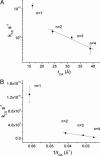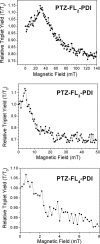Wire-like charge transport at near constant bridge energy through fluorene oligomers
- PMID: 15738410
- PMCID: PMC553316
- DOI: 10.1073/pnas.0408940102
Wire-like charge transport at near constant bridge energy through fluorene oligomers
Abstract
The study of photoinitiated electron transfer in donor-bridge-acceptor molecules has helped elucidate the distance dependence of electron transfer rates and behavior of various electron transfer mechanisms. In all reported cases, the energies of the bridge electronic states involved in the electron transfer change dramatically as the length of the bridge is varied. We report here, in contrast, an instance in which the length of the bridge, and therefore the distance over which the electron is transferred, can be varied without significantly changing the energies of the relevant bridge states. A series of donor-bridge-acceptor molecules having phenothiazine (PTZ) donors, 2,7-oligofluorene (FL(n)) bridges, and perylene-3,4:9,10-bis(dicarboximide) (PDI) acceptors was studied. Photoexcitation of PDI to its lowest excited singlet state results in oxidation of PTZ via the FL(n) bridge. In toluene, the rate constants for both charge separation and recombination as well as the energy levels of the relevant FL(n)(+.) bridge states for n = 1-4 are only weakly distance dependent. After the initial photo-generation of (1)(PTZ(+.)-FL(n)-PDI(-.)), radical pair intersystem crossing results in formation of (3)(PTZ(+.)-FL(n)-PDI(-.)) that recombines to give (3.)PDI. The dependence of the (3.)PDI yield on an applied magnetic field shows a resonance, which gives the singlet-triplet splitting, 2J, of the radical ion pair. The magnitude of 2J directly monitors the contribution of coherent charge transfer (superexchange) to the overall electron transfer rate. These data show that charge recombination through FL(n) is dominated by incoherent hopping at long distances.
Figures








Similar articles
-
Challenges in distinguishing superexchange and hopping mechanisms of intramolecular charge transfer through fluorene oligomers.J Phys Chem A. 2008 May 15;112(19):4410-4. doi: 10.1021/jp801084v. Epub 2008 Apr 18. J Phys Chem A. 2008. PMID: 18422290
-
Time-resolved EPR studies of charge recombination and triplet-state formation within donor-bridge-acceptor molecules having wire-like oligofluorene bridges.J Phys Chem A. 2010 May 13;114(18):5769-78. doi: 10.1021/jp101523n. J Phys Chem A. 2010. PMID: 20392075
-
Time-resolved EPR studies of photogenerated radical ion pairs separated by p-phenylene oligomers and of triplet states resulting from charge recombination.J Phys Chem B. 2006 Dec 21;110(50):25163-73. doi: 10.1021/jp063690n. J Phys Chem B. 2006. PMID: 17165960
-
Photoinduced electron transfer across molecular bridges: electron- and hole-transfer superexchange pathways.Chem Soc Rev. 2014 Jun 21;43(12):4005-18. doi: 10.1039/c3cs60463b. Chem Soc Rev. 2014. PMID: 24604096 Review.
-
Photoinduced charge and energy transfer in molecular wires.Chem Soc Rev. 2015 Feb 21;44(4):845-62. doi: 10.1039/c4cs00221k. Chem Soc Rev. 2015. PMID: 25212903 Review.
Cited by
-
On-off switch of charge-separated states of pyridine-vinylene-linked porphyrin-C60 conjugates detected by EPR.Chem Sci. 2015 Oct 1;6(10):5994-6007. doi: 10.1039/c5sc02051d. Epub 2015 Jul 9. Chem Sci. 2015. PMID: 29449913 Free PMC article.
-
New Molecular Scaffolds for Fluorescent Voltage Indicators.ACS Chem Biol. 2019 Mar 15;14(3):390-396. doi: 10.1021/acschembio.8b00978. Epub 2019 Feb 8. ACS Chem Biol. 2019. PMID: 30735344 Free PMC article.
-
Choosing sides: unusual ultrafast charge transfer pathways in an asymmetric electron-accepting cyclophane that binds an electron donor.Chem Sci. 2019 Mar 11;10(15):4282-4292. doi: 10.1039/c8sc05514a. eCollection 2019 Apr 21. Chem Sci. 2019. PMID: 31057755 Free PMC article.
-
Photoexcitation of dinucleoside radical cations: a time-dependent density functional study.J Phys Chem B. 2006 Nov 30;110(47):24181-8. doi: 10.1021/jp064524i. J Phys Chem B. 2006. PMID: 17125390 Free PMC article.
-
Vinyl-Fluorene Molecular Wires for Voltage Imaging with Enhanced Sensitivity and Reduced Phototoxicity.J Am Chem Soc. 2021 Aug 11;143(31):11903-11907. doi: 10.1021/jacs.1c04543. Epub 2021 Jul 29. J Am Chem Soc. 2021. PMID: 34323478 Free PMC article.
References
-
- Skourtis, S. & Nitzan, A. (2003) J. Chem. Phys. 119, 6271-6276.
-
- Weiss, E. A., Ahrens, M. J., Sinks, L. E., Gusev, A. V., Ratner, M. A. & Wasielewski, M. R. (2004) J. Am. Chem. Soc. 126, 5577-5584. - PubMed
-
- Nitzan, A. (2001) Annu. Rev. Phys. Chem. 52, 681-750. - PubMed
-
- Davis, W. B., Wasielewski, M. R., Ratner, M. A., Mujica, V. & Nitzan, A. (1997) J. Phys. Chem. A 101, 6158-6164.
-
- Davis, W. B., Svec, W. A., Ratner, M. A. & Wasielewski, M. R. (1998) Nature (London) 396, 60-63.
Publication types
MeSH terms
LinkOut - more resources
Full Text Sources
Miscellaneous

